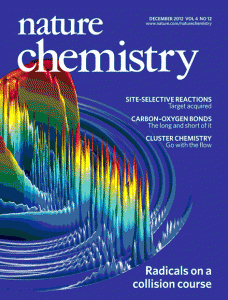 Our December issue went live today and I just wanted to highlight a few things here on the blog. The issue includes a focus on site-selective reactions, including an editorial, two Articles — one from the group of Scott Miller and the other from Martin Burke’s group — and a News & Views article from Jacobsen and Tadross looking at those two pieces of research. The editorial is completely free (all of those in Nature journals are) and the other three articles are free to those registered on nature.com. And if you’re not already registered, it is free to do so.
Our December issue went live today and I just wanted to highlight a few things here on the blog. The issue includes a focus on site-selective reactions, including an editorial, two Articles — one from the group of Scott Miller and the other from Martin Burke’s group — and a News & Views article from Jacobsen and Tadross looking at those two pieces of research. The editorial is completely free (all of those in Nature journals are) and the other three articles are free to those registered on nature.com. And if you’re not already registered, it is free to do so.
Elsewhere in the issue, we have two Thesis articles; one from our regular columnist Michelle Francl on why chemists like to name things like reactions, theories and equations after people who discovered/developed/derived them, and a guest essay from Dennis Curran, who — with tongue firmly in cheek — welcomes us to a brave new world of organic chemistry where it is more important what isn’t in your reactions than what is. Curran’s article is illustrated with the result of a fun photo shoot featuring homemade protest signs and five of the extended Nature Chemistry team.
The In Your Element article is another of our competition entries, this one about plutonium, and is also free to registered users. Our periodic table has been updated accordingly. The rest of the issue content is available to subscribers, and don’t miss the Review article ($) from Chris Chang and co-workers about reaction-based small-molecule fluorescent probes. As we usually do, we’ll get the Blogroll column, written by Karl D Collins, up here on the blog as soon as we can.
IMAGE: SARANDIS MARINAKIS
COVER DESIGN: ALEX WING





Please sign in or register for FREE
If you are a registered user on Research Communities by Springer Nature, please sign in